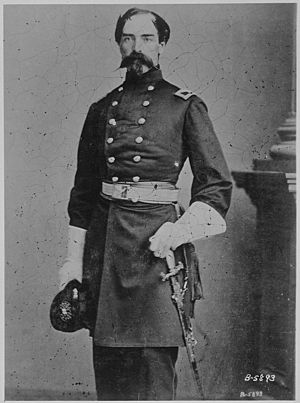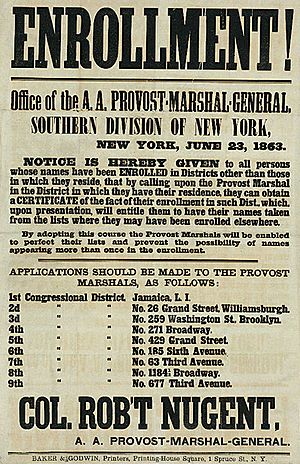Robert Nugent (officer) facts for kids
Quick facts for kids
Robert Nugent
|
|
|---|---|
 |
|
| Born | June 27, 1824 Kilkeel, County Down, Ireland |
| Died | June 20, 1901 (aged 76) Brooklyn, New York, U.S. |
| Buried |
Cypress Hills National Cemetery
|
| Allegiance | United States of America Union |
| Service/ |
Union Army |
| Years of service | 1861–1879 |
| Rank | |
| Unit | 13th U.S. Infantry Regiment 24th U.S. Infantry Regiment |
| Commands held | 69th New York Infantry Irish Brigade |
| Battles/wars | American Civil War New York Draft Riots American Indian Wars |
Brigadier General Robert Nugent (June 27, 1824 – June 20, 1901) was a brave officer in the U.S. Army. He was born in Ireland and later became an American citizen. He played an important role during the American Civil War and in conflicts known as the Indian Wars.
Contents
Robert Nugent: A Civil War Hero
Robert Nugent began his military service with the 69th New York Infantry Regiment. This unit started as a local defense group, called a militia. It later joined the main Union Army when the Civil War began. Nugent was one of the top officers in this regiment during the First Battle of Bull Run.
Serving in the Civil War
After their first 90 days of service ended, Nugent became a captain in the regular army. He was asked to join the 13th Infantry Regiment by its leader, Colonel William Tecumseh Sherman. Nugent then took a break to help organize the famous Irish Brigade in New York.
The 69th Infantry Regiment was the first unit to join the Irish Brigade. Nugent became its colonel and led the "Fighting 69th" in many major battles. These included the Battles of Fair Oaks, Gaines Mill, Savage Station, White Oak Swamp, Glendale, and Malvern Hill.
Facing the Draft Riots
During the Battle of Fredericksburg, Nugent was shot in the stomach. Because of his injury, he had to step down from his command. He was then given a new job by the U.S. War Department. He became an acting assistant for the draft in New York City and Long Island. The draft was a system to choose people for military service.
Since Nugent was Irish and a Democrat, many hoped his appointment would make sure the draft was fair for Irish-Americans. A newspaper called The Irish-American said his selection was "wise and deservedly popular." Nugent tried to keep the draft selections quiet. But in Manhattan, the draft lotteries were held in Irish neighborhoods where many people were against the draft.
This led to the New York Draft Riots. Nugent took charge of troops to try and protect the city from the rioters. Even after the draft was canceled, the riots continued for almost a week. During this time, rioters broke into and burned Nugent's home. His wife and children barely escaped.
In October, Nugent was replaced by General William Hayes. Nugent returned to active duty in November 1864. He took command of the Irish Brigade again. He led them in battles like Spotsylvania and the Petersburg and Appomattox Campaigns. He was the last leader of the Irish Brigade. He and his brigade marched in the victory parade in Washington, D.C. after the war ended.
After the War
On March 13, 1865, Nugent was given the honorary rank of Brigadier General for his excellent leadership. The soldiers of the Irish Brigade were honorably discharged a few months later. However, Nugent stayed in the regular U.S. Army for another twenty years. He served in conflicts on the Great Plains with the 13th and 24th Infantry Regiments.
In 1879, he retired as a major. He lived in New York and was active in groups for war veterans. These included the Grand Army of the Republic and the War Veterans' Association of the 7th Regiment. He was also an honorary member of The Old Guard.
His Final Years
As he grew older, Robert Nugent became ill. His old wounds from the Battle of Fredericksburg caused him problems. He was bedridden for two months before he passed away at his home in Brooklyn. He was buried at Cypress Hills National Cemetery, as he had wished.


